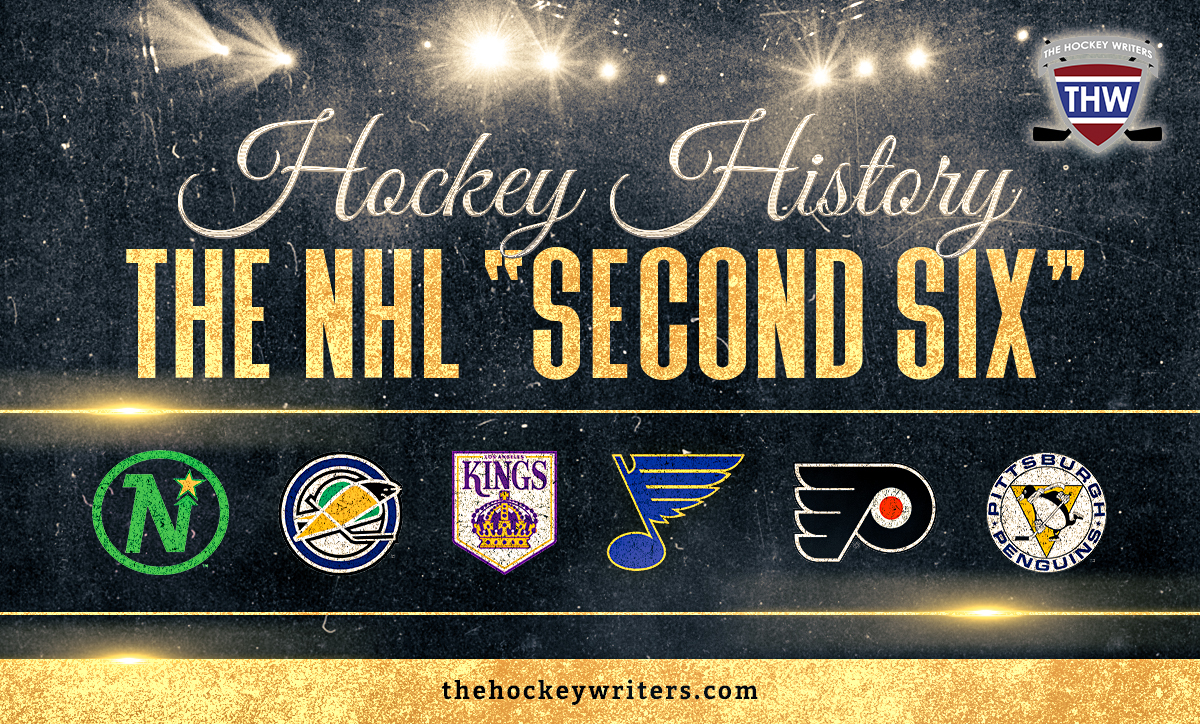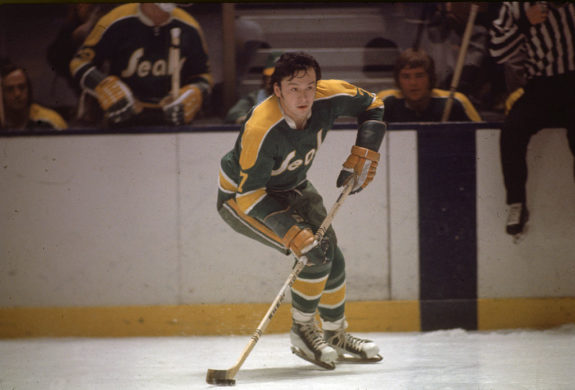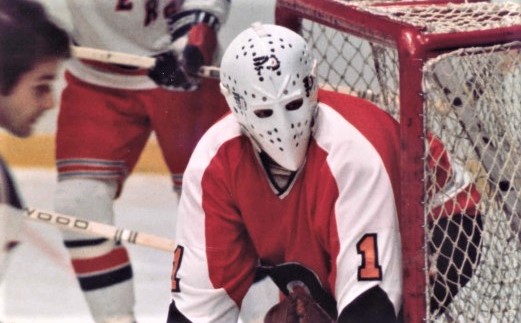In March 1965, a formal process began headed by then NHL President Clarence Campbell so that the league would expand its operation to include a second division of six teams. Gone would be the days of the so-called “Original Six” franchises. Joining them would be a half-dozen new teams that would see the NHL reach further into the United States, including both the Midwest and West Coast.
Numerous cities sought to be a landing spot for one of these six new teams, including places that were initially passed over by the NHL such as Cleveland, Buffalo, Vancouver, Louisville and Baltimore. Some of these same cities would eventually house NHL franchises as the league continued to experience growth and stability.

However, it would be early in 1966 that the league determined the six new acceptable cities which would be awarded an NHL team. These “Second Six” of the NHL were comprised of the Minnesota North Stars, Oakland Seals, Los Angeles Kings, St. Louis Blues, Philadelphia Flyers, and Pittsburgh Penguins. They were housed in their own division, called the West Division at the time. For the first time in league history, 12 teams competed for the Stanley Cup beginning in the 1967-68 season.
THW takes a look at each of these teams and how each fared upon their arrival into the NHL. It will be a fun history lesson as we look back upon the early trials and tribulations of each squad, and ultimately either their successes or failures within their first few years.
Minnesota North Stars
In the six-team West Division, the North Stars finished in fourth place that first year, thus grabbing the last playoff spot. In what has come to be known as affectionately as the “Pee-Wee Hockey Capital of the World”, Minnesota was a natural hockey market for the NHL. While it took the North Stars time to have any real successes, they were a viable franchise throughout their first few years of existence.
Having acquired him in the 1967 NHL Expansion Draft, goaltender Cesare Maniago remained Minnesota’s steadfast goaltender for nine straight seasons. Eventually, he would be joined by 40-year-old Stanley Cup champion and eventual Hockey Hall of Famer, Lorne “Gump” Worsley. The two would remain a goaltending duo for the North Stars for a little more than four seasons together.
Somewhat surprisingly, the North Stars had the top goal-scorer of the six expansion teams that first year. Wayne Connelly scored 35 goals in 74 games and tied with Phil Espositio and Norm Ullman for fourth most in the league. Connelly was the only player on an expansion team to place in the top-10 for that category.
The North Stars would have off and on success for the remainder of their existence. Original North Star Bill Goldsworthy scored 48 goals for the team during the 1973-74 season, which is still the fifth-highest total in franchise history. The team would make two Stanley Cup Final appearances (1981, 1991). Sadly though, the North Stars would be relocated to Dallas for the 1993-94 season where they became known simply as the Stars. The move has left many fans still heartbroken to this day.
Oakland Seals
The Oakland Seals were the most colorful franchise in terms of their personality and character. However, on the ice, they struggled immensely. Of the six expansion teams, they finished in last place during the 1967-68 season with a record of 15-42-17. They would make the playoffs only twice in their brief nine-year existence. This certainly did not keep them from being themselves. The Seals did everything from wearing white skates at one point, to distributing yellow and green suitcases to their players, eventually changing their colors to teal and gold, and even hiring a young lady to streak naked across the ice as a publicity stunt.

Any off-ice oddities that the Seals brought forth could not compensate for their difficulties on the ice. They developed a penchant for giving up valuable draft picks or prospects in exchange for players who were past their primes. For example, the Montreal Canadiens general manager Sam Pollock was able to secure the Seals’ first-round draft pick in the 1971 draft in order to snatch the legendary Guy Lafleur, while giving up a Habs’ first round selection in 1970. While the deal was certainly fair and within the rules, it ended up with the Seals giving up their opportunity to have taken a legendary player.
To encompass more of a Bay Area fanbase, the Oakland Seals became the California Golden Seals starting for the 1970-71 season. Once their jerseys were switched to being primarily teal in 1974-75 they dropped the “Golden” and became simply the California Seals. Despite young and talented players such as Reggie Leach, Gilles Meloche, Dennis Maruk, and Charlie Simmer, the Seals could not remain viable and eventually were relocated to Ohio where they became the short-lived Cleveland Barons.
Los Angeles Kings
The other California-based team was the Los Angeles Kings. One of the more noteworthy aspects of the first-year Kings was that their goaltender was arguably the greatest netminder to ever play the game, Terry Sawchuk. At 38 years old, Sawchuk manned the nets for 36 games as an original King and compiled a record of 10-17-5. He also recorded the 101st and 102nd shutouts of his long, masterful career.
Aside from a lone season of Sawchuk, Los Angeles had some younger forwards like Eddie Joyal, Real Lemieux, Ted Irvine, and “Cowboy” Bill Flett who all helped lead the team during its early years. During the 1968-69 season, Joyal became the club’s first 30-goal scorer when he tallied 33 that year. Shortly after their inaugural season, Los Angeles drafted Robert “Butch” Goring in the fifth round of the 1969 NHL Amateur Draft and he became a 30-goal scorer for the team spanning more than a decade.
The Kings never really gained much of a face around the league until the 1970s. Through trades and draft selections, they ended up comprising more of an identity. The likes of Marcel Dionne, Rogatien Vachon, Dave Taylor, and Charlie Simmer all arrived later on the scene and really made the Kings more recognizable.
Though the Kings would eventually garner success after they acquired Dionne from the Detroit Red Wings in 1975, hockey never truly took off in California until “The Great One” Wayne Gretzky arrived on the scene in 1988. Since that time hockey has remained popular in the “Golden State” and the Kings won the Stanley Cup in 2012 and 2014.
St. Louis Blues
The St. Louis Blues were the one team to earn immediate success. With Scotty Bowman at the helm in his first stop of what would be the most illustrious NHL coaching career, the early Blues were a grand collection of hockey’s “golden oldies”. In the first season alone, the team included the likes of Red Berenson, Al Arbour, Dickie Moore, Glenn Hall and Doug Harvey – all Stanley Cup champions, and four of which were eventually inducted into the Hockey Hall of Fame. Additionally, reliable role players such as Jim Roberts, the Plager brothers Barclay and Bob, Noel Picard, Gerry Melnyk, and numerous others were difference makers.
Coming out of the West that year, the Blues were the first of the expansion teams to make the Stanley Cup Final which they lost in four games to the Montreal Canadiens. The Blues would reach the Final three years in a row, as they distinguished themselves to be the best of the six new teams. With three straight losses over the Stanley Cup to “Original Six” teams, and with the addition of the Buffalo Sabres and Vancouver Canucks into the NHL in 1970, the teams were realigned and no expansion team was guaranteed a spot in the Cup Final from that point forward.
For the 1968-69 season, Bowman would have Hall and Jacques Plante as his goaltenders. That year the two shared the Vezina Trophy as the two goalies allowing the fewest goals against. Having such strong goaltending with two legends who fed off of one another increased the strength of the Blues tenfold. Were it not for such savvy goaltending, St. Louis would not have made the three straight runs at the Cup in 1968, 1969 and 1970.
In the first 50 years that the St. Louis Blues have been in existence, they have only played in the Stanley Cup Final those first three years. They have had many other great players in the history of their franchise, including Bernie Federko, Brett Hull, Adam Oates, Chris Pronger, Curtis Joseph, Grant Fuhr, Al MacInnis, Pavol Demitra, Vladimir Tarasenko and others, but they have not yet recaptured those initial glory days of the organization.
Philadelphia Flyers
The expansion Philadelphia Flyers were more of an aged guard when it came to skaters, but backstopped by a young and upcoming tandem in goal. Early Flyers Larry Zeidel and Allan Stanley were in their 40s during the first few years of the team, while many other players were well into their 30s. Stanley played his 21st NHL season – his only with Philadelphia – during the 1968-69 campaign. During the first season of 1967-68, only two Flyers even reached the 20-goal plateau – Bill Sutherland and Leon Rochefort, with 20 and 21 goals respectively.
Anchoring a potential rise for the Flyers were two 22-year-old goalies, Doug Favell and Bernie Parent. In the first year they split the goaltending duties right down the middle, appearing in 37 and 38 games. Favell became the main goalie for the Flyers for six straight seasons until he was traded to the Toronto Maple Leafs during the summer of 1973 – oddly enough, in exchange for Parent.

Parent, who had began his NHL career with the Boston Bruins, was with Philadelphia from the expansion until he was traded to the Maple Leafs early in 1971. After three seasons in Toronto where he gained tutelage from the great Jacques Plante as his goaltender partner he was back with the Flyers. He would play six seasons in Philadelphia and would backstop them to two straight Stanley Cups for the 1973-74 and 1974-75 seasons.
With Parent as their cornerstone, the Flyers became arguably the most feared NHL team of the 1970s. That stemmed namely from having coach Fred “The Fog” Shero at the helm and his orchestration of the Flyers’ “Broad Street Bullies” – Dave “The Hammer” Schultz, Bob “Hound Dog” Kelly, Andre “Moose” Dupont, Don “Big Bird” Saleski, and team captain and face of the Flyers Bobby Clarke. Philadelphia was the first expansion team to win the Stanley Cup.
Pittsburgh Penguins
The expansion Pittsburgh Penguins were led by the bullet-shooting Andy Bathgate. An eventual Hockey Hall of Famer, Bathgate was the club’s top-scorer during the 1967-68 season when he tallied 20 goals and 39 assists for 59 points in 74 games at the age of 35. Even though the Penguins would join the Seals in failing to make the playoffs during the first year, it helped matters that they had a player already regarded as a legend who was giving them firepower.
Bathgate played in the minors for two seasons after the first year, before he made a return to the Penguins for the 1970-71 season. He would finish third on the team in scoring behind Bryan Hextall Jr. and Jean Pronovost that year. With no real names other than Bathgate’s to bring anything close to stardom, Pittsburgh made the playoffs only twice in their first seven years.
The other important key contributor during the Penguins early years was goaltender Les Binkley. An affable individual, Binkley never made his NHL debut until he had joined the Penguins and was well into his 30s. Originally playing maskless, he was the first starting goaltender in Pittsburgh’s history. He would remain between the pipes for the team up through the 1971-72 season, before jumping over to the rival WHA.
Oddly enough, it was Binkley who would bridge the gap for the franchise. While the Penguins were never a true contender for the Stanley Cup in their first two decades, Binkley was a member of the team’s first two Stanley Cup victories in 1991 and 1992. He earned Cup rings and saw his name engraved on the silver chalice having served the team as a scout. Of course, those winning Penguins teams were led by the likes of Jaromir Jagr, Ron Francis, Kevin Stevens, Larry Murphy, Bryan Trottier, Paul Coffey, Tom Barrasso, and the premier face of the Pittsburgh Penguins, Mario Lemieux.
Sign up for our NHL History Substack newsletter

Comments are closed.